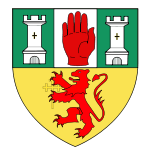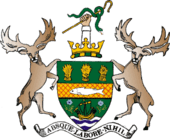List of townlands in Belfast
The townlands of Belfast are the oldest surviving land divisions in Belfast, Northern Ireland. The city is split between two traditional Counties by the River Lagan, with those townlands north of the river generally in County Antrim, while those on the southern bank are generally part of County Down.
The following is a list of townlands within Belfast city (excluding the suburbs of Newtownabbey, Holywood and Dundonald) and their likely etymologies.
County Antrim (north bank of the River Lagan)
- Ballyaghagan (from Irish Baile Uí Eachagáin, meaning 'O'Hagan's townland')
- Ballycollin (from Baile Uí Coileain meaning "O'Collin's townland")
- Ballycullo (from Baile Cúile Eo meaning "townland of the nook of the yew")
- Ballydownfine (from Baile Dhún Fionn meaning "town of the white fort" or Baile Dhún Finn meaning "town of Finn's fort")
- Ballyfinaghy (from Baile an Fhionnachaidh meaning "townland of the white field")
- Ballygammon (formerly Ballyogoman, from Baile Ó gComáin meaning "O'Coman's townland")
- Ballygomartin (from Baile Gobha Mairtín meaning "town of Martin the smith" or Baile Gharraí Mháirtín, "townland of Martin's enclosed field")
- Ballymagarry (formerly Ballingarry, from Baile an Gharraí meaning "townland of the enclosed field", or from Baile Mac Gearoidh meaning "McGarry's townland")
- Ballymoney (formerly Ballymeighmoney, from Baile Maighe Muine meaning "townland of the plain of the peat")
- Ballymurphy (from Baile Uí Mhurchú or Baile Uí Mhurchaidh meaning "Murphy's townland")
- Ballysillan Lower (from Baile na Saileán meaning "townland of the willows")
- Derryaghy (from Doire Achaidh meaning "oak-grove of the field" / from Doire Eachadh meaning "Eochy's oak-grove")
- Dunmurry (from Dún Muirígh meaning "Muiríoch's fort")
- Edenderry (from Éadan Doire meaning "hill-face of the oak-grove")
- Englishtown (an English name)
- Greencastle (an English name), formerly Cloghcastella (from Cloch Mhic Coisteala meaning "Costello's stone castle")
- Killeaton (from Coill Eatain meaning "Eatan's wood")
- Kilmakee (from Coill Mhic Ciaigh meaning "McKay's wood")
- Lagmore (from Lag Mór meaning "the great hollow")
- Legoniel (from Lag an Aoil meaning "hollow of the limestone")
- Low Wood (an English name)
- Malone Lower and Malone Upper (from Maigh Luain meaning "Luan's plain")
- Old Park (an English name)
- Poleglass (from Poll Glas meaning "the green hollow")
- Skegoneill (formerly Ballyskeighoginerla, from Sceitheog an Iarla meaning "the earl's little thorn bush" – the name Sceitheog Uí Néill, "O'Neill's little thorn bush" has also been proposed)
- Tom of the Tae-End (a Scottish name, the term given to the skin a haggis is stuffed into, possibly named by a Scottish settler due to its size and shape)[1]
County Down (south bank of the River Lagan)
- Ballycloghan (from Baile Clocháin meaning "townland of the stepping stones")
- Ballydollaghan (from Baile Uí Dhúlacháin meaning "O'Dollaghan's townland")
- Ballyhackamore (from Baile an Chacamair meaning "townland of the mud flat")
- Ballyhanwood (formerly Ballyhenod, from Baile Sheanóid meaning "Henwood's townland")
- Ballylenaghan (from Baile Uí Leannacháin meaning "O'Lenaghan's townland")
- Ballymacarret (from Baile Mhic Gearóid meaning "McGarrett's townland" or Baile Mhic Airt, "McArt's townland")
- Ballymaconaghy (from Baile Mhic Dhonnchaidh meaning "McDonaghy's townland")
- Ballymaghan (from Baile Uí Mhiachain meaning "O'Meehan's townland")
- Ballymisert (formerly Ballymagher, from Baile Machaire meaning "townland of the plain")
- Ballynafoy or Ballynafeigh (from Baile na Faiche meaning "townland of the lawn")
- Ballynavally (formerly Ballyomulvalleh, from Baile Uí Mhaolbhallaigh meaning "O'Mulwally's townland" / from Baile na Fáile meaning "townland of the slope")
- Ballyrushboy (from Baile Rois Buí meaning "townland of the yellow wood")
- Braniel (from Broinngheal meaning "white-fronted place")
- Breda (from Bréadach meaning "fragmented land")
- Carnamuck (from Ceathrú na Muc meaning "quarterland of the pigs")
- Castlereagh (from Caisleán Riabhach meaning "grey castle")
- Cregagh (from Creagaigh meaning "rocky place")
- Gallwally (from Gallbhaile meaning "foreigner's townland")
- Gilnahirk (formerly Edengillnahirk, from Éadan Ghiolla na hAdhairce meaning "hill-brow of the horn bearer")
- Gortgrib (from Gort Grib "field of the mire" or Gort Cirb, "field of the cut/trench")
- Killeen (from Coillín meaning "small wood")
- Knock (from Cnoc meaning "hill"), formerly Knock Columkill (from Cnoc Cholm Cille, "Colm Cille's hill")
- Knockbreckan (from Cnoc Bhreacáin meaning "Breacán's hill")
- Knocknagoney (from Cnoc na gCoiníní meaning "hill of the rabbits")
- Lisnasharragh (from Lios na Searrach meaning "ringfort of the foals")
- Multyhogy (from Muilte Sheoigigh meaning "Seoigigh's/Joyce's mills")
- Strand Town (an English name), formerly Ballimachoris (from Baile Mhic Fheorais, "McCorish's townland")
- Tullycarnet (formerly Tullycarnan, from Tulaigh Charnáin meaning "hillock of the little cairn")
gollark: I mean, I don't find combat very fun anyway, so meh.
gollark: Alternatively, fork the mod and change two lines of code or so!
gollark: Well, automated-ish, then.
gollark: Perhaps turtles.
gollark: I wonder if there's some convoluted way to autokill it.
References
- "Heritage and Place Names". Colin Glen Trust. 2010. Retrieved 15 August 2010.
- Ordnance Survey Ireland – Online map viewer (choose 'historic' to see townland boundaries)
- Placenames NI
This article is issued from Wikipedia. The text is licensed under Creative Commons - Attribution - Sharealike. Additional terms may apply for the media files.

